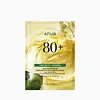What's inside
What's inside
 Key Ingredients
Key Ingredients

 Benefits
Benefits

 Concerns
Concerns

No concerns
 Ingredients Side-by-side
Ingredients Side-by-side

Water
Skin ConditioningButylene Glycol
HumectantGlycerin
HumectantCetyl Ethylhexanoate
EmollientCaprylic/Capric Triglyceride
MaskingDimethicone
EmollientPolyglyceryl-3 Methylglucose Distearate
EmulsifyingOryza Sativa Extract
AbsorbentGlyceryl Stearate
EmollientPEG-100 Stearate
1,2-Hexanediol
Skin ConditioningCarbomer
Emulsion StabilisingTromethamine
BufferingGlyceryl Caprylate
EmollientCentella Asiatica Extract
CleansingXanthan Gum
EmulsifyingEthylhexylglycerin
Skin ConditioningPaeonia Suffruticosa Root Extract
Skin ProtectingChamomilla Recutita Flower Extract
MaskingDisodium EDTA
Parfum
MaskingAloe Barbadensis Leaf Juice
Skin ConditioningSodium Hyaluronate
HumectantWater, Butylene Glycol, Glycerin, Cetyl Ethylhexanoate, Caprylic/Capric Triglyceride, Dimethicone, Polyglyceryl-3 Methylglucose Distearate, Oryza Sativa Extract, Glyceryl Stearate, PEG-100 Stearate, 1,2-Hexanediol, Carbomer, Tromethamine, Glyceryl Caprylate, Centella Asiatica Extract, Xanthan Gum, Ethylhexylglycerin, Paeonia Suffruticosa Root Extract, Chamomilla Recutita Flower Extract, Disodium EDTA, Parfum, Aloe Barbadensis Leaf Juice, Sodium Hyaluronate
Houttuynia Cordata Extract 80%
Skin ConditioningButylene Glycol
HumectantWater
Skin ConditioningDipropylene Glycol
Humectant1,2-Hexanediol
Skin ConditioningGlycerin
HumectantHydroxyacetophenone
AntioxidantCellulose Gum
Emulsion StabilisingCarbomer
Emulsion StabilisingAllantoin
Skin ConditioningPolyglyceryl-10 Laurate
Skin ConditioningCitric Acid
BufferingArginine
MaskingDisodium EDTA
Betaine
HumectantPanthenol
Skin ConditioningBiosaccharide Gum-1
HumectantTheobroma Cacao Extract
Skin ConditioningSodium Hyaluronate
HumectantDextrin
AbsorbentHydrolyzed Hyaluronic Acid
HumectantSodium Acetylated Hyaluronate
HumectantHouttuynia Cordata Extract 80%, Butylene Glycol, Water, Dipropylene Glycol, 1,2-Hexanediol, Glycerin, Hydroxyacetophenone, Cellulose Gum, Carbomer, Allantoin, Polyglyceryl-10 Laurate, Citric Acid, Arginine, Disodium EDTA, Betaine, Panthenol, Biosaccharide Gum-1, Theobroma Cacao Extract, Sodium Hyaluronate, Dextrin, Hydrolyzed Hyaluronic Acid, Sodium Acetylated Hyaluronate
 Reviews
Reviews

Ingredients Explained
These ingredients are found in both products.
Ingredients higher up in an ingredient list are typically present in a larger amount.
1,2-Hexanediol is a synthetic liquid and another multi-functional powerhouse.
It is a:
- Humectant, drawing moisture into the skin
- Emollient, helping to soften skin
- Solvent, dispersing and stabilizing formulas
- Preservative booster, enhancing the antimicrobial activity of other preservatives
Butylene Glycol (or BG) is used within cosmetic products for a few different reasons:
Overall, Butylene Glycol is a safe and well-rounded ingredient that works well with other ingredients.
Though this ingredient works well with most skin types, some people with sensitive skin may experience a reaction such as allergic rashes, closed comedones, or itchiness.
Learn more about Butylene GlycolCarbomer is a polymer of acrylic acid. Its main role is to create a gel consistency.
A high amount of carbomer can cause pilling or balling up of products. Don't worry, most products contain 1% or less of carbomer.
Disodium EDTA plays a role in making products more stable by aiding other preservatives.
It is a chelating agent, meaning it neutralizes metal ions that may be found in a product.
Disodium EDTA is a salt of edetic acid and is found to be safe in cosmetic ingredients.
Learn more about Disodium EDTAGlycerin is already naturally found in your skin. It helps moisturize and protect your skin.
A study from 2016 found glycerin to be more effective as a humectant than AHAs and hyaluronic acid.
As a humectant, it helps the skin stay hydrated by pulling moisture to your skin. The low molecular weight of glycerin allows it to pull moisture into the deeper layers of your skin.
Hydrated skin improves your skin barrier; Your skin barrier helps protect against irritants and bacteria.
Glycerin has also been found to have antimicrobial and antiviral properties. Due to these properties, glycerin is often used in wound and burn treatments.
In cosmetics, glycerin is usually derived from plants such as soybean or palm. However, it can also be sourced from animals, such as tallow or animal fat.
This ingredient is organic, colorless, odorless, and non-toxic.
Glycerin is the name for this ingredient in American English. British English uses Glycerol/Glycerine.
Learn more about GlycerinSodium Hyaluronate is hyaluronic acid's salt form. It is commonly derived from the sodium salt of hyaluronic acid.
Like hyaluronic acid, it is great at holding water and acts as a humectant. This makes it a great skin hydrating ingredient.
Sodium Hyaluronate is naturally occurring in our bodies and is mostly found in eye fluid and joints.
These are some other common types of Hyaluronic Acid:
Learn more about Sodium HyaluronateWater. It's the most common cosmetic ingredient of all. You'll usually see it at the top of ingredient lists, meaning that it makes up the largest part of the product.
So why is it so popular? Water most often acts as a solvent - this means that it helps dissolve other ingredients into the formulation.
You'll also recognize water as that liquid we all need to stay alive. If you see this, drink a glass of water. Stay hydrated!
Learn more about Water